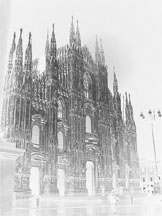Cultural Sightseeing Tours in Milan
 |
Started in 1386, the Duomo represents a great witness of the particular Lombard Gothic style. Consecrated to S. Maria Nascente, wanted by Gian Galeazzo Visconti, it stands on the site of the late Middle Ages Basilica di S. Maria Maggiore. It is a huge marble building with a rich variety of statues, spires, buttresses, rampant arches, pillars. The statues are over 3,500, including the 96 giants of the spouts. The Cathedral, divided in five naves, is 157 m. long at the exterior and 92 m. large at the transept with a whole area of 11.700 sq.m.
|
 |
Two immortal artists have left to history this temple which rises in the square with the same name: Donato Bramante and Leonardo da Vinci. The Church was built between 1466 and 1490 on a project by the architect Guiniforte Solari. However a few years later, Ludovico il Moro called for Bramante, who built a new apse area leaving the sign of his art in the magnificent Tribuna, example of spatial architecture of Renaissance.
|
 |
Sixteen centuries of history are mirrored in the basilica di S. Ambrogio (in the square with the same name), queen and mother of all Lombard churches. The Basilica, which has been started in 379 A.D., was dedicated in 387 by Sant'Ambrogio, who was buried there in 397. The interior gathers monuments, antiques, relics, art works of 1600 years of history. The portico della Canonica, a project by Bramante, the oratory of San Sigismondo and the rich Treasure of the basilica are particularly precious.
|
 |
Important witness of Roman and Early-Christian in Milan, this Church is at Corso di Porta Ticinese, facing the sixteen Roman Corinthian columns once belonging to a temple of III century which lead to the church square where there is a bronze copy of the Emperor Costantino’s statue. The basilica, originally from the end of IV century – beginning of V, after several fires and collapses has been restored many times.
|
 |
This temple, which after S. Ambrogio is the most important medieval monument in Milan, is in the square with the same name, in the quarter of Porta Ticinese. Maybe it has been built by the bishop Eustorgio (315-331), who wanted to be buried there and brought there the relics of the Magi from Costantinopoli, was rebuilt under a Romanesque style during XII century. Behind the apse there is the Portinari Chapel, wanted by Pigello Portinari, one of the most important works of Lombard Renaissance made by two rooms with a squared plan, covered by cupolas with multicoloured decors typically from Lombardy.
|
 |
The restoration in 1900 have brought it to the original Romanesque lines of XI century. There Alessandro Manzoni was baptized. It is notable also the ancient column of the "Leone di Porta Orientale", by Giuseppe Robecco (1626), facing the entrance of the Church.
|
 |
This church was built around 1254 by brother Lanfranco Settala, in the site where there was a church consecrated to the Saint, as a sign of gratitude towards Venetians who helped Milan citizens to rebuild the town after the destruction of Barbarossa. On its walls there are precious frescos, one of them is attributed to the school of Leonardo and represents the Madonna with the Baby in her arms, while she blesses S. Giovannino); it has been found out only recently.
|
 |
This basilica is at Via Torino, a few meters from Piazza del Duomo. A new building was started in 1476. In 1478 Donato Bramante was supervising the works leaving the sign of his genius using the available space in a wonderful way, above all creating the illusion of a depth with a prospective game of arcades and coffered ceilings with a false apse. The façade, started by Amadeo on a project by Bramante, was rebuilt in Renaissance style in the past century. The church tower (X-XII cent.) can be considered the prototype of the Lombard-Romanesque models.
|
 |
Founded in 1030 by Benedetto Rozone, was adapted several times. At the end of 1800, the façade has been however brought to the ancient Lombard shape. The wide Crypt dating back to the foundation time, occupies the whole length of the Church.
|
 |
The basilica is one of the first churches built in Milan. Sant'Ambrogio wanted this building in IV cent. and it was finished only under his successor San Simpliciano, who was buried there. In the year 398 the basilica welcomed also the relics of three martyrs: Sisinio, Martirio and Alessandro. In the interior, in the apse basin, the great coronation of Maria, a fresco by Borgognone. The church is linked to the memory of the battle of Legnano: the windows of the façade represent the "Glorie del Carroccio" (glories of the Carroccio).
|
